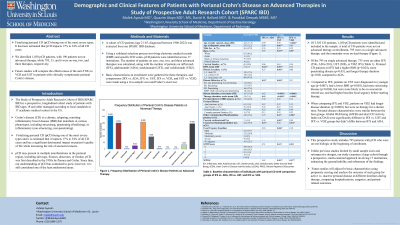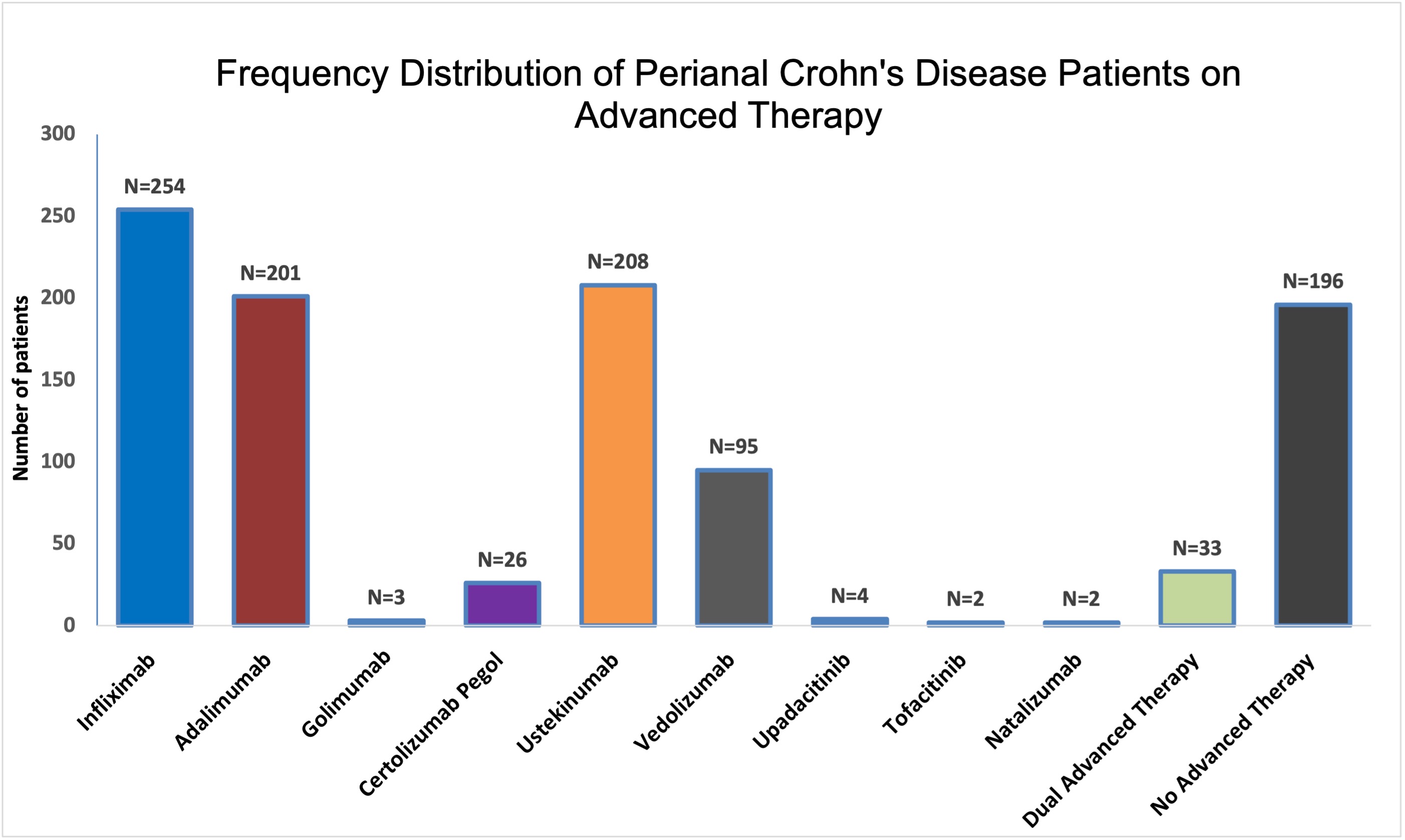Tuesday Poster Session
Category: IBD
P4330 - Demographic and Clinical Features of Patients with Perianal Crohn’s Disease on Advanced Therapies in Study of Prospective Adult Research Cohort (SPARC IBD)
Tuesday, October 29, 2024
10:30 AM - 4:00 PM ET
Location: Exhibit Hall E

Has Audio

Malek Ayoub, MD
Washington University School of Medicine in St. Louis
St. Louis, MO
Presenting Author(s)
Malek Ayoub, MD1, Quazim Alayo, MD, MSc1, David Ballard, MD1, Parakkal Deepak, MBBS, MS2
1Washington University School of Medicine in St. Louis, St. Louis, MO; 2Washington University in St. Louis, St. Louis, MO
Introduction: Crohn’s disease (CD) is a chronic, relapsing, and remitting inflammatory bowel disease. Fistulizing perianal CD (pCD) is one of the most severe phenotypes, affecting 17% to 34% of all CD cases. This significantly impacts patients' quality of life and increases the risk of anorectal cancers. However, there are very few prospective cohorts worldwide.
Methods: A cohort of CD patients (aged 21-85, diagnosed between 1960-2022) was extracted from the prospective longitudinal SPARC IBD cohort of the IBD Plexus. Using a validated selection process involving electronic medical records (EMR) and specific ICD codes, pCD patients were identified across 17 institutions. Patients on advanced therapies were identified. Basic demographics and clinical characteristics of patients on Infliximab (IFX), Adalimumab (ADA), Ustekinumab (UST), or Vedolizumab (VDZ) at enrollment were gathered. Comparisons (IFX vs. ADA, IFX vs. UST, IFX vs. VDZ) were made using a one-way ANOVA followed by pairwise comparison (means) and Chi-Square test (proportions).
Results: Of 3,383 CD patients, 1,030 pCD patients were identified and included in the sample. A total of 196 patients were not on advanced therapy at enrollment, 795 were on a single advanced therapy, and the remainder were on dual therapy (Figure 1). Of the 795 on single advanced therapy, 735 were on either IFX (254), ADA (201), UST (208), or VDZ (95) (Table 1). Perianal CD patients on IFX had a higher BMI (p=0.024), more penetrating disease (p=0.03), and longer therapy duration (p=0.02) compared to ADA. Compared to IFX, patients on UST were diagnosed at a younger age (p=0.007), had a lower BMI (p=0.003), had more stricturing disease (p=0.004), but were more likely to be on concurrent steroid use, and had higher baseline fecal urgency before starting therapy. When comparing IFX and VDZ, patients on VDZ had longer disease duration (p< 0.0001) but were on therapy for a shorter time. Perianal disease characteristics were similar between the four groups. Global Well-being (GWB) and short CD Activity Index (sCDAI) were significantly different in IFX vs. UST and IFX vs. VDZ groups but didn’t differ between IFX and ADA.
Discussion: We described the baseline demographic and clinical characteristics of a large prospective cohort of pCD patients on advanced therapies from a prospective, multi-centered study in the United States. Future studies will assess the prospectively determined clinical outcomes by comparing hospitalizations, surgeries, and patient-related outcomes.

Note: The table for this abstract can be viewed in the ePoster Gallery section of the ACG 2024 ePoster Site or in The American Journal of Gastroenterology's abstract supplement issue, both of which will be available starting October 27, 2024.
Disclosures:
Malek Ayoub, MD1, Quazim Alayo, MD, MSc1, David Ballard, MD1, Parakkal Deepak, MBBS, MS2. P4330 - Demographic and Clinical Features of Patients with Perianal Crohn’s Disease on Advanced Therapies in Study of Prospective Adult Research Cohort (SPARC IBD), ACG 2024 Annual Scientific Meeting Abstracts. Philadelphia, PA: American College of Gastroenterology.
1Washington University School of Medicine in St. Louis, St. Louis, MO; 2Washington University in St. Louis, St. Louis, MO
Introduction: Crohn’s disease (CD) is a chronic, relapsing, and remitting inflammatory bowel disease. Fistulizing perianal CD (pCD) is one of the most severe phenotypes, affecting 17% to 34% of all CD cases. This significantly impacts patients' quality of life and increases the risk of anorectal cancers. However, there are very few prospective cohorts worldwide.
Methods: A cohort of CD patients (aged 21-85, diagnosed between 1960-2022) was extracted from the prospective longitudinal SPARC IBD cohort of the IBD Plexus. Using a validated selection process involving electronic medical records (EMR) and specific ICD codes, pCD patients were identified across 17 institutions. Patients on advanced therapies were identified. Basic demographics and clinical characteristics of patients on Infliximab (IFX), Adalimumab (ADA), Ustekinumab (UST), or Vedolizumab (VDZ) at enrollment were gathered. Comparisons (IFX vs. ADA, IFX vs. UST, IFX vs. VDZ) were made using a one-way ANOVA followed by pairwise comparison (means) and Chi-Square test (proportions).
Results: Of 3,383 CD patients, 1,030 pCD patients were identified and included in the sample. A total of 196 patients were not on advanced therapy at enrollment, 795 were on a single advanced therapy, and the remainder were on dual therapy (Figure 1). Of the 795 on single advanced therapy, 735 were on either IFX (254), ADA (201), UST (208), or VDZ (95) (Table 1). Perianal CD patients on IFX had a higher BMI (p=0.024), more penetrating disease (p=0.03), and longer therapy duration (p=0.02) compared to ADA. Compared to IFX, patients on UST were diagnosed at a younger age (p=0.007), had a lower BMI (p=0.003), had more stricturing disease (p=0.004), but were more likely to be on concurrent steroid use, and had higher baseline fecal urgency before starting therapy. When comparing IFX and VDZ, patients on VDZ had longer disease duration (p< 0.0001) but were on therapy for a shorter time. Perianal disease characteristics were similar between the four groups. Global Well-being (GWB) and short CD Activity Index (sCDAI) were significantly different in IFX vs. UST and IFX vs. VDZ groups but didn’t differ between IFX and ADA.
Discussion: We described the baseline demographic and clinical characteristics of a large prospective cohort of pCD patients on advanced therapies from a prospective, multi-centered study in the United States. Future studies will assess the prospectively determined clinical outcomes by comparing hospitalizations, surgeries, and patient-related outcomes.

Figure: Figure 1. Frequency Distribution of Perianal Crohn's Disease Patients on Advanced Therapy.
Note: The table for this abstract can be viewed in the ePoster Gallery section of the ACG 2024 ePoster Site or in The American Journal of Gastroenterology's abstract supplement issue, both of which will be available starting October 27, 2024.
Disclosures:
Malek Ayoub indicated no relevant financial relationships.
Quazim Alayo indicated no relevant financial relationships.
David Ballard: Merck – Consultant.
Parakkal Deepak: AbbVie – Consultant, Grant/Research Support. Alimentiv – Grant/Research Support. Arena Pharmaceuticals – Grant/Research Support. Boehringer Ingelheim – Grant/Research Support. Bristol Myers Squibb-Celgene – Advisory Committee/Board Member, Grant/Research Support. CorEvitas LLC – Consultant. Janssen – Grant/Research Support. Pfizer – Grant/Research Support. Prometheus Biosciences – Grant/Research Support. Roche/Genentech – Advisory Committee/Board Member. Scipher Medicine – Grant/Research Support. Takeda – Grant/Research Support.
Malek Ayoub, MD1, Quazim Alayo, MD, MSc1, David Ballard, MD1, Parakkal Deepak, MBBS, MS2. P4330 - Demographic and Clinical Features of Patients with Perianal Crohn’s Disease on Advanced Therapies in Study of Prospective Adult Research Cohort (SPARC IBD), ACG 2024 Annual Scientific Meeting Abstracts. Philadelphia, PA: American College of Gastroenterology.
